You know what I absolutely love about talong (eggplant)? It's like that underrated vegetable that somehow makes everything better. I've probably tried it a hundred different ways, but this Ginataang Talong is something else entirely.
I'm a huge fan of how eggplant soaks up all the flavors like a sponge. And in this recipe, it's drinking up that rich coconut milk and savory pork goodness. You get that perfect spoonful of eggplant that's crispy on the outside but melt-in-your-mouth tender inside, all coated in that velvety sauce.
What is Ginataang Talong?
Ginataang Talong is a traditional Filipino dish where tender eggplants and succulent pork belly are simmered in coconut milk until a rich, velvety sauce develops. The dish gets its depth from the interplay of smoky pan-fried eggplant, fatty pork, and the subtle heat of Thai chilies, all balanced by the creamy coconut base. This one-pan meal exemplifies Filipino home cooking's knack for transforming simple ingredients into something greater than their parts, creating a dish that's both humble and luxurious.
Jump to:
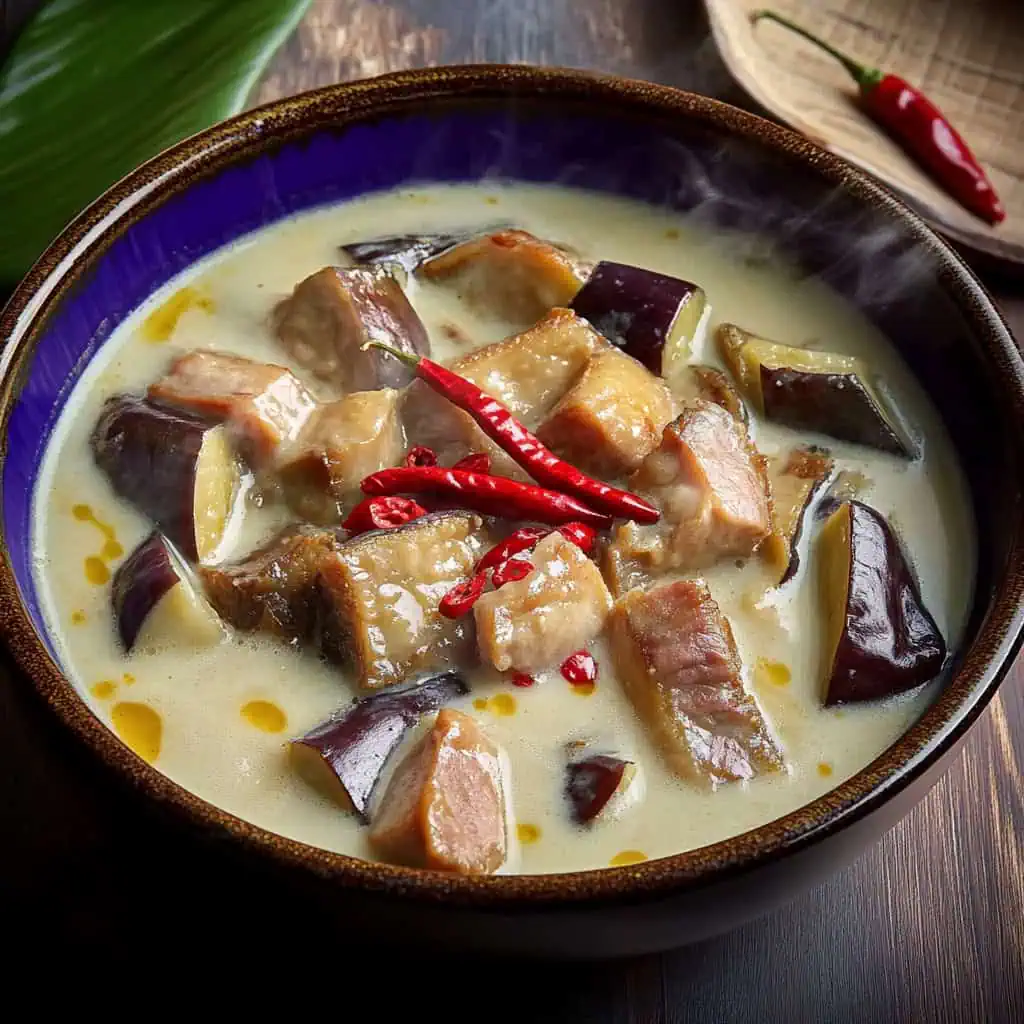
Why You'll Love This Recipe
- One-pan cooking means easy cleanup
- Rich, creamy sauce that's perfect with rice
- Budget-friendly yet satisfying
- Customizable heat level
- Authentic Filipino comfort food
- Great make-ahead dish
Ingredients
The ingredients in this Ginataang Talong create a perfect harmony of flavors and textures. Eggplant serves as the star with its ability to absorb flavors while maintaining a creamy texture when cooked. Pork belly adds rich, savory notes and satisfying fat that balances the dish.
Coconut cream provides a velvety, slightly sweet base that carries all the flavors while tempering the heat from Thai chilies. Onions and garlic create an aromatic foundation, while fish sauce contributes that essential umami depth without overpowering.
This careful combination results in a dish where each element enhances the others – the creaminess mellows the spice, the pork enriches the eggplant, and everything comes together in a perfectly balanced Filipino comfort food classic.

- 5 large eggplants, stems removed and cut into 1-inch pieces
- 1 pound pork belly, cut into ½-inch strips
- 1 can (13.5 ounces) coconut cream
- 1 medium onion, peeled and chopped
- 2 cloves garlic, peeled and minced
- 3 Thai chili peppers, stemmed and minced
- 1 tablespoon fish sauce
- 1 cup water
- Canola oil for frying
- Salt and pepper to taste
Equipment
- Large deep skillet or kawali: Provides even heat distribution and contains the sauce properly during simmering
- Sharp knife: Essential for uniform cutting of ingredients, ensuring even cooking
- Wooden spoon: Prevents scratching of pan coating and is perfect for gentle stirring of the coconut sauce
- Measuring cups and spoons: Ensures precise ingredient portions for consistent results
- Colander: Used for draining eggplants after soaking or frying
- Paper towels: Helps remove excess oil from fried eggplants
- Heavy-bottomed pot with lid: Alternative cooking vessel if using braising method
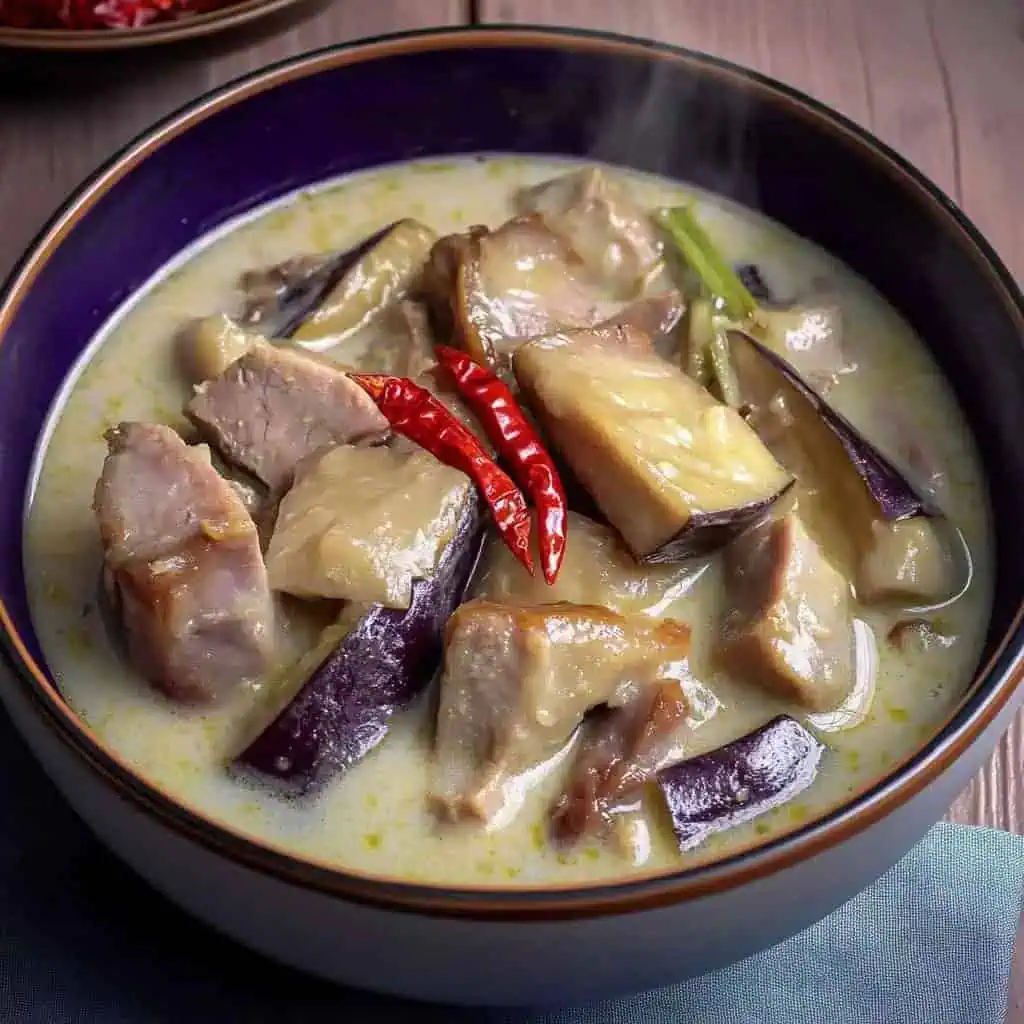
How To Make
- Heat two tablespoons of oil in a wide pan over medium heat (350°F/175°C). Cut the eggplants into 1-inch pieces and pan-fry them until lightly browned on all sides, about 2-3 minutes per side. Remove the eggplants with a slotted spoon and let them drain on paper towels.
- Add another tablespoon of oil to the same pan if needed. Add the chopped onions and cook until they become clear and soft, about 3-4 minutes. Add the minced garlic and cook for another 30 seconds until you can smell its aroma.
- Put in the pork belly strips and cook them until they turn golden brown, about 3-4 minutes. Pour in the fish sauce and let it cook for 1-2 minutes while stirring occasionally.
- Pour in the coconut cream and water, then stir everything together. Add the minced chili peppers. Turn the heat down to medium-low (325°F/163°C), cover the pan, and let it simmer for 15-20 minutes or until the pork becomes tender. If the sauce starts to dry out before the pork is cooked, add more water, half a cup at a time.
- Put the cooked eggplant pieces back into the pan and stir them gently into the sauce. Cook for another 3-5 minutes until the eggplants are tender and the sauce starts to thicken and release some oil on top. Taste the dish and add salt and pepper as needed.
- Serve hot with steamed rice. For the best experience, let the dish rest for 5 minutes before serving to allow the flavors to settle and the sauce to thicken slightly.
Note: If at any point the coconut sauce starts to bubble too vigorously, lower the heat immediately. A gentle simmer is key to preventing the coconut milk from breaking and keeping the sauce smooth and creamy.

Tips from Lola's Kitchen
- Prevent eggplant discoloration: Soak cut eggplant in salted water for 15 minutes before cooking to prevent browning and reduce bitterness.
- Proper frying technique: Don't overcrowd the pan when frying eggplants – this ensures each piece browns properly rather than steaming.
- Coconut milk maintenance: Always let coconut milk simmer, never boil, to prevent curdling and separation.
- Flavor enhancer: For extra aromatic depth, add a stalk of bruised lemongrass during simmering, then remove before serving.
- Pork preparation: Score pork belly skin in a crosshatch pattern for better flavor absorption and more even cooking.
- Oil separation: The small amount of orange oil that rises to the top of your dish is a good sign – it means the coconut cream has been properly cooked and released its natural oils.
- Rest before serving: Allow the dish to rest for 5-10 minutes after cooking; this helps the flavors meld together and the sauce to reach the perfect consistency.
Substitutions
- Protein options: Replace pork belly with chicken thighs, firm tofu, or mushrooms for different protein alternatives.
- Heat adjustment: Substitute Thai chilies with long green chilies for milder heat or bird's eye chilies for more intense spiciness.
- Coconut options: If coconut cream isn't available, use regular coconut milk plus 2 tablespoons of coconut cream powder to achieve similar richness.
- Garlic substitute: In a pinch, substitute fresh garlic with 1 teaspoon garlic powder.
- Fish sauce alternative: Use 1 tablespoon soy sauce plus a pinch of salt as a fish sauce replacement.
- Different vegetables: You can add string beans, bell peppers, or squash to the dish for more variety and nutrition.
Troubleshooting
- Sauce too thin: If your sauce is watery, simmer uncovered for 5-10 additional minutes to reduce and thicken.
- Curdled sauce: If the coconut sauce starts breaking or curdling, lower the heat immediately and stir gently until it recombines.
- Bitter eggplant: For particularly bitter eggplants, soak in salt water for 30 minutes before cooking, then rinse thoroughly.
- Tough pork: If pork remains tough after recommended cooking time, extend simmering by 10-15 minutes, adding small amounts of water as needed.
- Too spicy: If the dish becomes too spicy, add an extra ¼ cup coconut cream to mellow the heat.
- Burnt taste: If you accidentally burn the bottom, transfer contents to a new pan without scraping the burnt bits.
Storage & Reheating
- Refrigerator storage: Store leftovers in an airtight container for up to 3 days in the refrigerator.
- Freezer option: Freeze in a freezer-safe container for up to 2 months, though be aware the sauce may separate slightly upon thawing.
- Proper reheating: Reheat on low heat on the stovetop, stirring gently to prevent breaking the sauce.
- Moisture maintenance: Add 2-3 tablespoons water when reheating to restore the creamy consistency.
- Flavor development: Like many stewed dishes, Ginataang Talong often tastes even better the next day as flavors continue to develop.
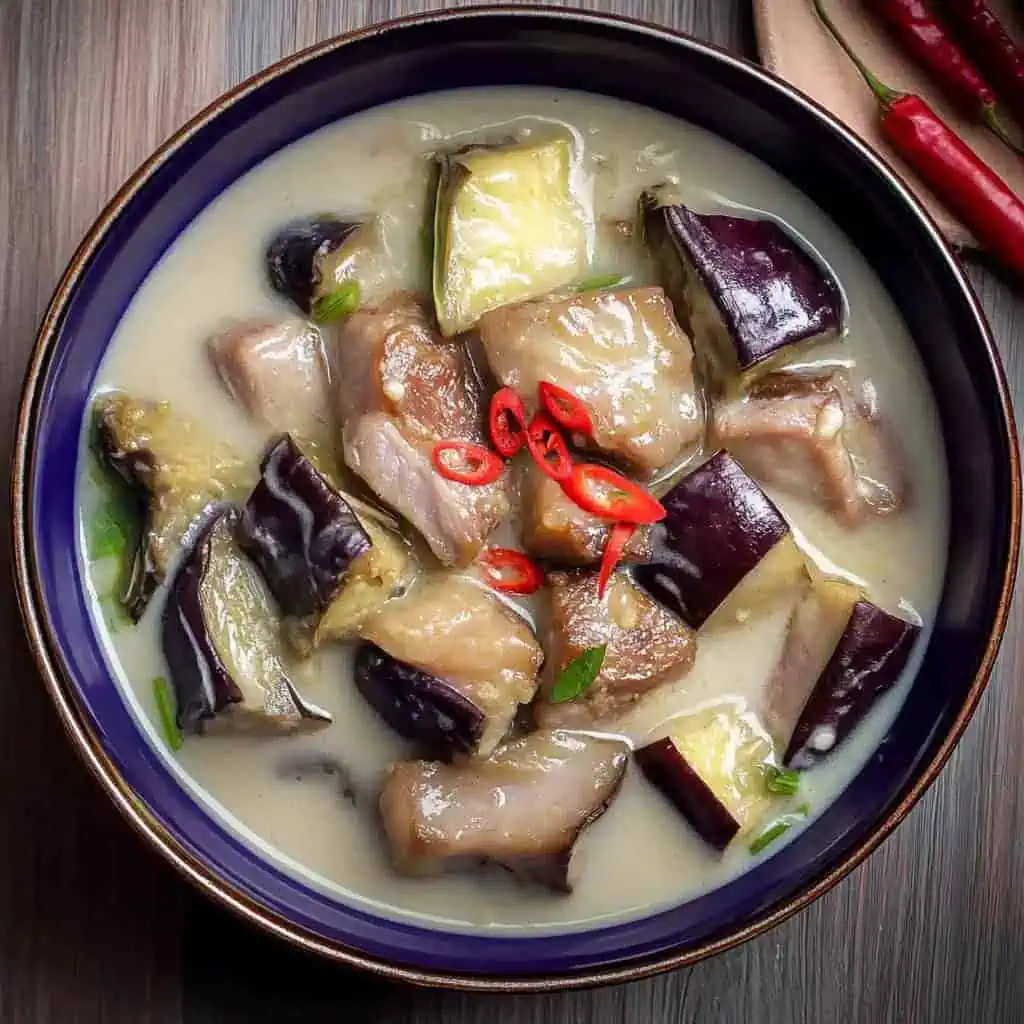
FAQ
Can I make this in advance?
Yes, this dish actually tastes better the next day as the flavors have more time to meld. Reheat gently on the stovetop to preserve the creamy texture.
Is this dish spicy?
The recipe as written has moderate heat. You can easily adjust by changing the number of chilies used – fewer for milder taste, more for extra spice.
Can I use regular eggplant instead of Asian eggplants?
Yes, though Asian eggplants are preferred for their sweeter flavor and fewer seeds, regular globe eggplants work well too. Just be sure to cut them into slightly smaller pieces.
Is there a way to make this dish lower in fat?
You can use leaner cuts like pork loin instead of belly, or substitute with chicken breast. You can also reduce oil by using a non-stick pan and blotting excess oil from the pork.
Why did my coconut sauce curdle?
Coconut milk can separate if cooked at too high a temperature. Always maintain a gentle simmer and avoid boiling the sauce.
Can I make this in a slow cooker?
Yes, brown the eggplant and pork separately first, then combine all ingredients in a slow cooker on low for 4-5 hours. Add the eggplant during the last hour to prevent it from becoming mushy.
What's the best type of eggplant to use?
Long Asian eggplants are traditional and ideal because they have thinner skin, fewer seeds, and a sweeter flavor profile.
My sauce is too watery, what should I do?
Remove the lid and continue simmering until the sauce reaches your desired thickness. You can also mix 1 teaspoon cornstarch with 1 tablespoon water and stir it in for quicker thickening.
Related
Looking for other recipes like this? Try these:

Ginataang Talong (Eggplant and Pork in Coconut Milk)
Equipment
- Large deep skillet or kawali for even heat distribution and sauce containment)
- Sharp knife (kutsilyo) for uniform cutting of ingredients
- Wooden spoon prevents scratching of pan coating
- Measuring cups and spoons (Panukat) for precise ingredients portions
- Colander (salaan) for draining eggplants
- Paper towels for removing excess oil
- Heavy-bottomed pot with lid if using alternative braising method
Ingredients
- 5 large eggplants talong, stems removed and cut into 1-inch pieces
- 1 pound pork belly liempo, cut into ½-inch strips
- 1 can 13.5 ounces coconut cream (kakang gata)
- 1 medium onion sibuyas, peeled and chopped
- 2 cloves garlic bawang, peeled and minced
- 3 Thai chili peppers siling pangsigang, stemmed and minced
- 1 tablespoon fish sauce patis
- 1 cup water tubig
- Canola oil for frying mantika
- Salt asin and pepper (paminta) to taste
Instructions
- Heat two tablespoons of oil in a wide pan over medium heat (350°F/175°C). Cut the eggplants into 1-inch pieces and pan-fry them until lightly browned on all sides, about 2-3 minutes per side. Remove the eggplants with a slotted spoon and let them drain on paper towels.
- Add another tablespoon of oil to the same pan if needed. Add the chopped onions and cook until they become clear and soft, about 3-4 minutes. Add the minced garlic and cook for another 30 seconds until you can smell its aroma.
- Put in the pork belly strips and cook them until they turn golden brown, about 3-4 minutes. Pour in the fish sauce and let it cook for 1-2 minutes while stirring occasionally.
- Pour in the coconut cream and water, then stir everything together. Add the minced chili peppers. Turn the heat down to medium-low (325°F/163°C), cover the pan, and let it simmer for 15-20 minutes or until the pork becomes tender. If the sauce starts to dry out before the pork is cooked, add more water, half a cup at a time.
- Put the cooked eggplant pieces back into the pan and stir them gently into the sauce. Cook for another 3-5 minutes until the eggplants are tender and the sauce starts to thicken and release some oil on top. Taste the dish and add salt and pepper as needed.
- Serve hot with steamed rice. For the best experience, let the dish rest for 5 minutes before serving to allow the flavors to settle and the sauce to thicken slightly.
- Note: If at any point the coconut sauce starts to bubble too vigorously, lower the heat immediately. A gentle simmer is key to preventing the coconut milk from breaking and keeping the sauce smooth and creamy.
Tips from Lola's Kitchen
- Soak cut eggplant in salted water to prevent oxidation (pagkaitim)
- Don't overcrowd the pan when frying eggplants
- Let coconut milk simmer, never boil, to prevent curdling
- For extra flavor, add lemongrass (tanglad) during simmering
- Score pork belly skin for better flavor absorption
Nutrition
The Story Behind Ginataang Talong
Every time I think about Ginataang Talong, I'm reminded of how Filipino cuisine masterfully transforms humble ingredients into extraordinary dishes. This beloved recipe, which literally translates to "eggplant in coconut milk," embodies the heart of Filipino cooking, where Chinese influences meet Malay traditions and Spanish colonial heritage. The use of coconut milk (gata) in Filipino cuisine dates back centuries, particularly in regions where coconut trees flourish abundantly along coastal areas.
What makes this dish particularly special is its roots in rural Filipino kitchens, where families would often grow eggplants in their backyard gardens. The combination of homegrown talong with coconut milk created a practical yet luxurious dish that made the most of available ingredients. Traditional cooks would often gather fresh coconuts early in the morning, grate them by hand, and squeeze out the cream for the day's cooking – a practice some households still maintain today for that unmistakably fresh flavor.
In my family, Ginataang Talong was our go-to dish during the rainy season, when the comfort of warm, creamy coconut sauce became especially appealing. My grandmother would always say that the secret lies in how you cook the eggplants – they should be perfectly browned but not burnt, creating that subtle smokiness that makes this dish so distinctive. The addition of pork belly, a later evolution of the originally vegetarian dish, reflects how Filipino recipes adapt and grow while maintaining their essential character.
The beauty of Ginataang Talong also lies in its regional variations. In Bicol, known for its love of spicy food, the dish gets an extra kick from native chilies. In Quezon province, where coconut production thrives, they're famous for using kakang gata (first-press coconut cream) for an exceptionally rich sauce. Some coastal areas even have versions that incorporate dried fish or shrimp paste, adding an umami depth that showcases Filipino cuisine's knack for building complex flavors from simple ingredients.
Today, this dish continues to evolve in modern Filipino kitchens while maintaining its soul-satisfying essence. Whether served in humble carinderias (local eateries) or upscale Filipino restaurants, Ginataang Talong remains a testament to the ingenuity of Filipino cooking – where everyday ingredients combine to create something truly extraordinary.
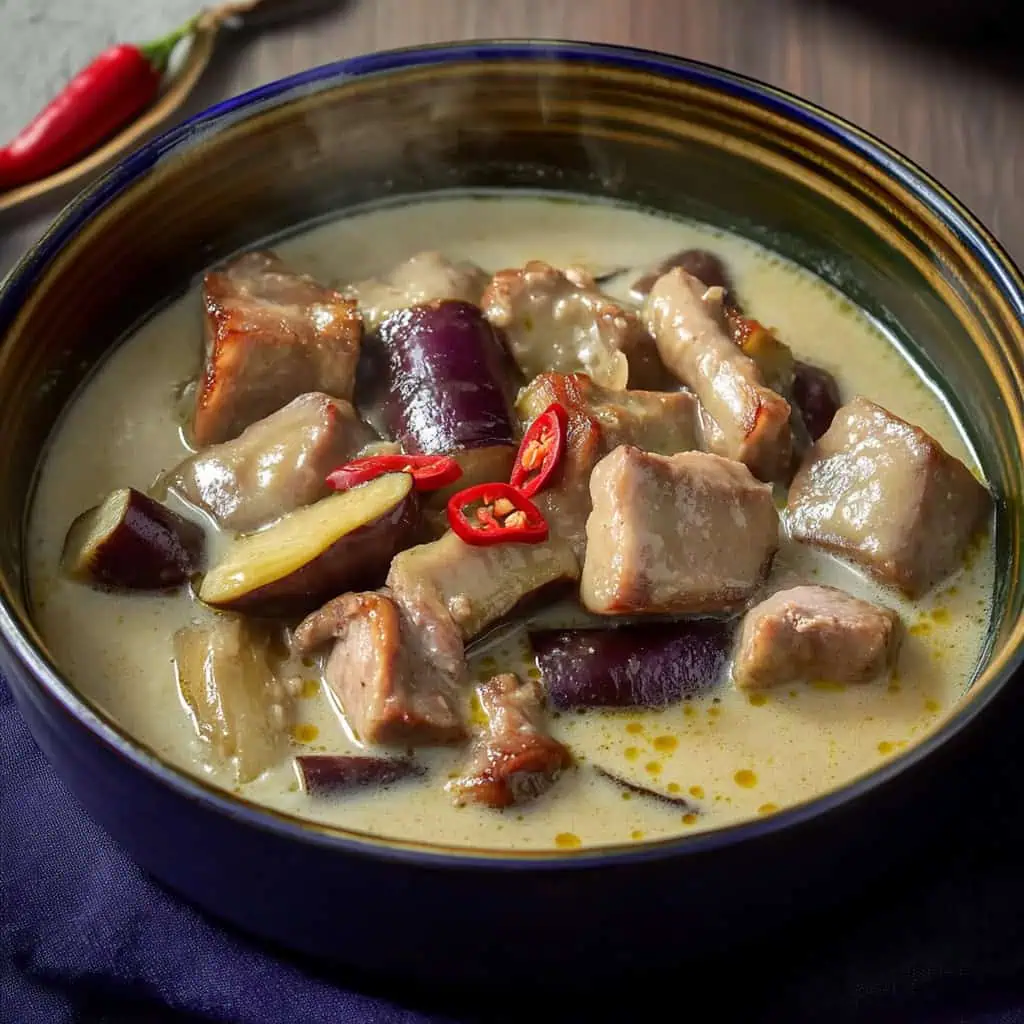





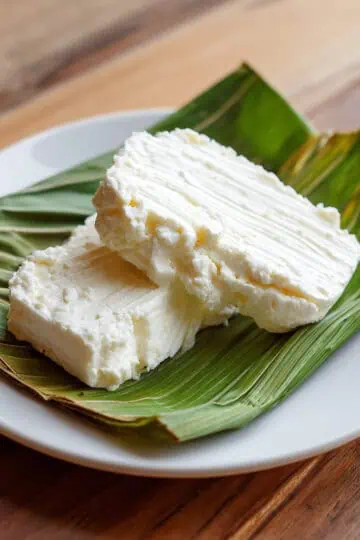



Comments
No Comments